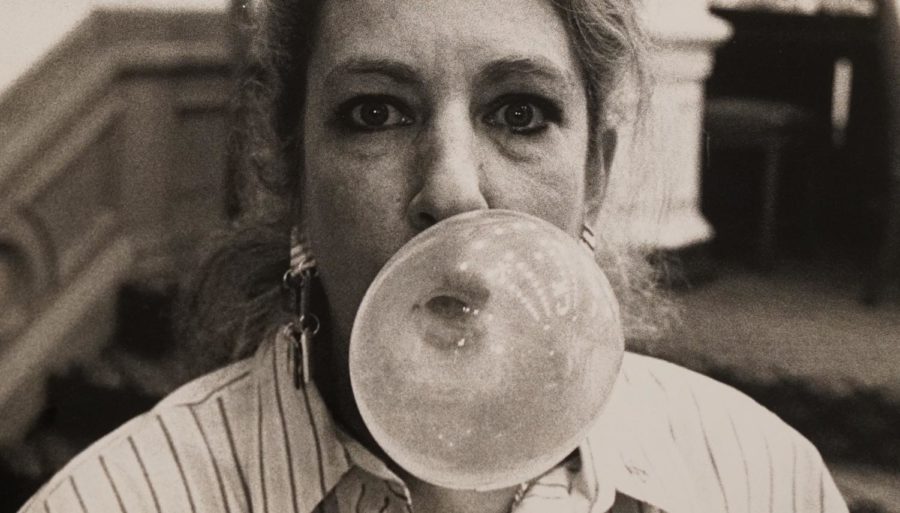Through Reichman’s lens
Substitute teacher remembers sights, sounds, stars and unforgettable stories from her prolific photojournalism career
Photo courtesy of Bette Reichman
Bette Reichman blows a bubble for the camera. An accomplished photojournalist before becoming a permanent sub at McCallum, Reichman said that she loved the power her camera afforded her on the legislative floor. “It was a power job,” Reichman said. “I got to boss people around. But in that capacity, I was bossing them around to get good pictures.”
April 12, 2023
The start of something special
The year was 2000.
It was the holiday season, an especially hectic time of year for photographers.
Bette Reichman was no novice to this time of year. She’d been photographing weddings, parties and events for about a decade.
This year, she had a Christmas party lined up to photograph. But there was a problem. A former client was asking for a favor. Former Texas governor George W. Bush asked if she was available to shoot his victory celebration.
But this time, it wasn’t just Gov. Bush asking for a favor. It was the newly declared President Bush who needed her. Her other client would just have to understand.
To many McCallum students, substitute teacher Bette Reichman may not seem like a woman who took pictures at the president’s Christmas parties. But Reichman had a long career as a photojournalist before she ever set foot in McCallum.
Reichman grew up in Houston and came to Austin to attend college at the University of Texas in the late ’60s. Women had limited professional opportunities at the time, so she became a nursing major, which, according to Reichman, was a mistake. Change was needed.
“I wanted to try to be an art major, but they wanted to change my style,” Reichman said. “So forget that.”
Art history, then. Close enough.
Reichman graduated from UT with a degree in art history and moved on to graduate school. While working on her thesis, she met and married her husband, who owned a camera store.
“He had me come work for him in the darkroom, splicing film,” Reichman said. “And I hated it. Hated it, hated it, hated it. One day, he said, because it was a family business, ‘If you don’t like it, you can quit.’ And so I went looking for a job.”
Reichman worked for a time at a high-end contemporary art gallery. Although she managed to escape her husband’s camera store, she couldn’t hide from photography for long. In the early ‘80s, Reichman discovered stereo photography, wherein the camera takes two images simultaneously with a certain distance between them to create an illusion of depth. This form of photography was perfect for Reichman, whose time studying art history taught her to think in dimensions.
“Everybody laughed at me because these cameras were very popular in the ‘50s, but they died out because there were a lot of problems [with them],” Reichman said. “But it was so me. And my husband and I traveled, and we were in Peru. I took these fabulous 3D pictures in Peru, and nobody laughed at me ever again.”
Stereoscopic cameras are completely manual, which means you have to think more critically when taking a picture. But this aspect helped Reichman learn the art of photography. Once she did, Reichman began taking more pictures here and there; she did ZACH Theatre production photos, for example. But everything changed when Reichman seized an opportunity to become a photographer for the Texas House of Representatives.
“That’s where I really found my abilities as a photographer,” Reichman said.
Up close and personal
The job at the House was different from what she was used to. It was demanding: Reichman and her colleagues would shoot around 20 or 30 rolls of film a day. She would take photos for the annual House calendar as well as group photos. More than that, though, Reichman was on the House floor, taking pictures of the representatives in action. Or, at least, the action she coaxed them to.
“A lot of times, you’ll see these pictures that look great, where they’re looking at a piece of paper and one of them’s pointing at it,” Reichman said. “They don’t do that naturally. So you set it up.”
Some might have been too intimidated to give orders to state representatives. But that didn’t seem to be an issue for Reichman. In fact, just the opposite.
“It was a power job,” Reichman said. “And that was part of what I loved about it. I got to boss people around. But in that capacity, I was bossing them around to get good pictures.”
But there was more to the job than just bossing around politicians.
“I was right there as a fly on the wall,” Reichman said. “And I got to hear all kinds of private conversations. That was one of the perks of the job at the Capitol, the gossip and the bullshit. You got to hear everything that was going on.”
Reichman was a regular on the House floor. She familiarized herself with well-known Texas politicians including George W. Bush and former governor Ann Richards—simply “Ann” to Reichman—but she also had the opportunity to photograph the biggest celebrities and politicians of the day.
Reichman photographed Kevin Costner when he was in Austin shooting a movie. She always did Bill Clinton and Obama when they came to town. She even snapped the Queen of England, which could have ended in disaster.
“I was supposed to stay in a certain place,” Reichman said. “But one of the people that worked for the legislature said, ‘No, get closer, get closer.’ And I said, ‘They’re gonna arrest me!’ They said, ‘Oh, well, if they arrest you, we’ll get you out.’ And so I was close enough to hear all kinds of things. I took the risk. I got good pictures.”
For Reichman, the money she earned taking pictures wasn’t the main motivation. Doing a good job was more important. Reichman would do whatever it took to get a good picture, even if it meant going a little rogue.
“[Photography] is about intuition, and in my case, working with people, because they’re expecting a certain product,” Reichman said. “One time, they called me to shoot this big event [for George W. Bush] at the Four Seasons. I’m talking to [a staff member], and I’m telling her I’m going to shoot from the waist up, [but] she wants them full-length. And I’m thinking, no, people have horrible body language. They do. But this girl, she wanted it her way. But I wasn’t gonna shoot it her way because I knew which was the right way.”
The right way was Reichman’s way.
“It all turned out well,” Reichman said. “But I did break a sweat, big time, ‘cause I thought, oh, I pissed off this little girl who probably has more power than me.”
Reichman worked as a photographer for the House of Representatives until 1992 when she had her son. She wanted a change. So she started her own photography business.
“I figured, OK, I’ve photographed all these people,” Reichman said. “I’ll let them know. I came up with a name for my business: Public Eye Photography for people in the public. I used to say it was for the famous, the infamous, and the unknown.”
Reichman continued to photograph politicians on both sides of the political aisle but also did good business photographing weddings. However, times were changing. Film cameras were no longer the mode du jour: they were quickly being overtaken by digital cameras. And even worse: cell phones. It just wasn’t worth investing in new technology that would quickly become obsolete. Plus, cell phones meant that everybody could be a photographer.
“I just thought, it’s time to hang it up,” Reichman said.
Moving on to Mac
Reichman quit photographing professionally in 2012, a couple of years after her son graduated high school. McCallum High School, to be precise. Reichman’s son was a vocal major, and she’d been an active member of the choir booster club. She even shot pictures at Cabaret and MacTheatre musicals during her son’s time at Mac. Reichman fell in love with the school. And her next steps became clear.
“I started subbing occasionally,” Reichman said. “I did one job at Anderson, one job at Lanier, and then I started subbing at McCallum more. And then I didn’t want to sub anywhere else.”
Reichman subbed so frequently at Mac that after about a year and a half, she was put on a list of permanent substitutes. Meaning: she doesn’t sub anywhere but Mac. Reichman lives close to McCallum, so easy physical access is definitely a factor. Additionally, the school was a familiar place to her after seeing her son through his four years there. But those aren’t the only reasons Reichman chose Mac.
“I love the students,” Reichman said. “I love the diversity. I love the creativity. [McCallum’s] the future for me.”
At McCallum, Reichman is surrounded by people who have their whole lives ahead of them. And that’s what she loves about it.
“Right now, lots of doors are open to everybody,” Reichman said. “There’s lots of hope. So when I see somebody that wants to be a dancer, I go, ‘Oh, that’s really exciting. Golly gee, I’d like to do that again.’ But I already had my turn to do whatever it was. So it’s wonderful watching everybody.”
Reichman has met a lot of different people in her life. She said it herself: ‘the famous, the infamous, and the unknown.’ But there’s no question that she’s impressed by her students. Though they might be ‘the unknown’ right now, Reichman is excited to watch McCallum’s students grow into their potential.
“I have people say, because my kid is 30, ‘Don’t you want grandkids?’” Reichman said. “I don’t need any grandkids. Why don’t I need any? Because I have you as my grandchildren.”
A gallery of Reichman’s favorite images
Lanie Sepehri sat down with Bette Reichman to find the stories behinds some of Reichman’s favorite images. Here is a sampling of Reichman’s all-time favorite photos and the stories of how they were captured.
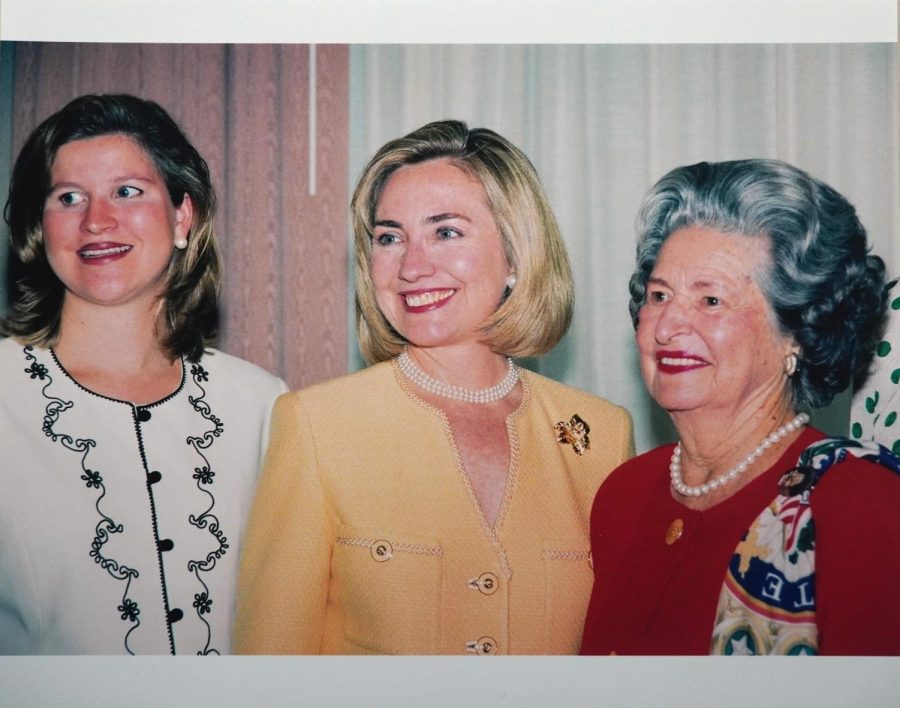
REICHMAN: “Do you know who those people are? Lady Bird Johnson and her granddaughter. Bill Clinton was president at the time, and Hillary came through for some sort of event that was held at the Renaissance. A lot of events were held at the Renaissance: the Renaissance or the Four Seasons. And it was a woman’s event. It was really quite exciting. I did all the grip and grins, and Hillary spoke and some of my favorite pictures from there—I don’t have any to show—you are Hillary with Liz Carpenter. Hillary was great. I photographed her a number of times, and she had a great sense of humor, and we’re virtually the same age, so we were on the same page.”
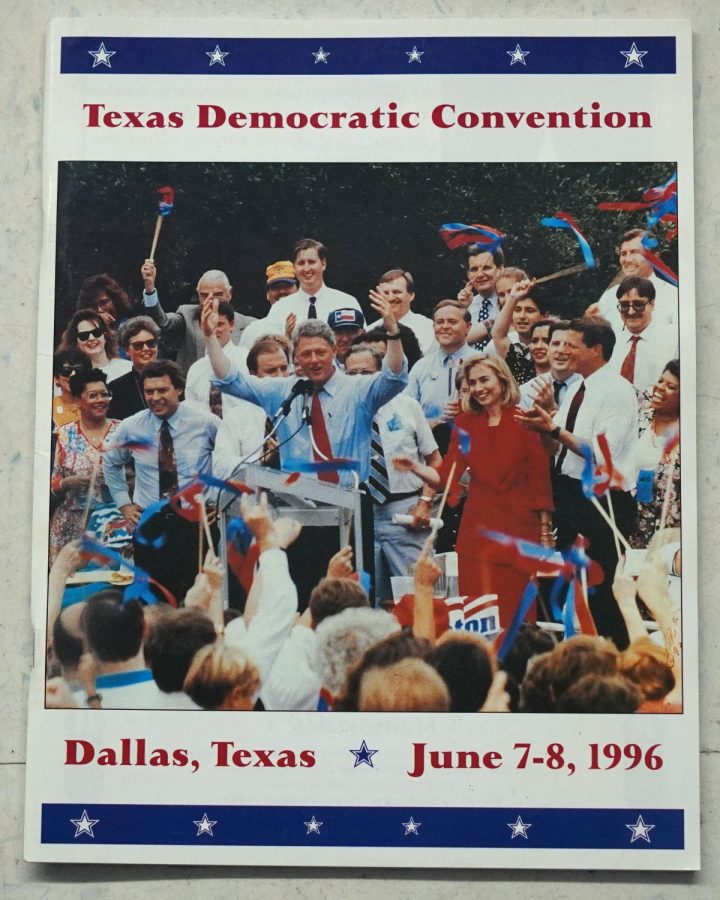
REICHMAN: “This was a favorite. It’s only a partial picture. I might have brought the original. If you notice, it’s cut off. There was an event that was held in August ’92. This was an event that was held at the LBJ Museum for LBJs birthday. I probably wouldn’t have gone because my son was only a couple of months old. But I was hired to shoot the attorney general and so I had to go, and I went ahead of time. Because it was a national event, I claimed my space and shot the attorney general. … It was a fabulous event. Everybody was there, everybody that was an elected official in Texas and Al Gore and Tipper Gore … and Glenn Maxey, the first gay House Representative, everybody was there. The actual picture, like I say is much wider and broader. And I gifted the Texas Democratic Party a big one of it, which they then used it at this convention without giving me a photo credit. I wish I could have sued them. But then that wouldn’t have been nice. I was not happy though because the picture actually popped up in a neighborhood newspaper. I opened [the newspaper] to the picture and I said, “That looks like my picture.’ So then I went got my picture, and I looked, and I went, ‘That’s my picture.’ I call the guy to say ‘Where’d you get the picture?’ And he says ‘from the Texas Democratic Party.’ But it was fabulous event. The big picture is great. I have a big one at home that’s a mounted.”
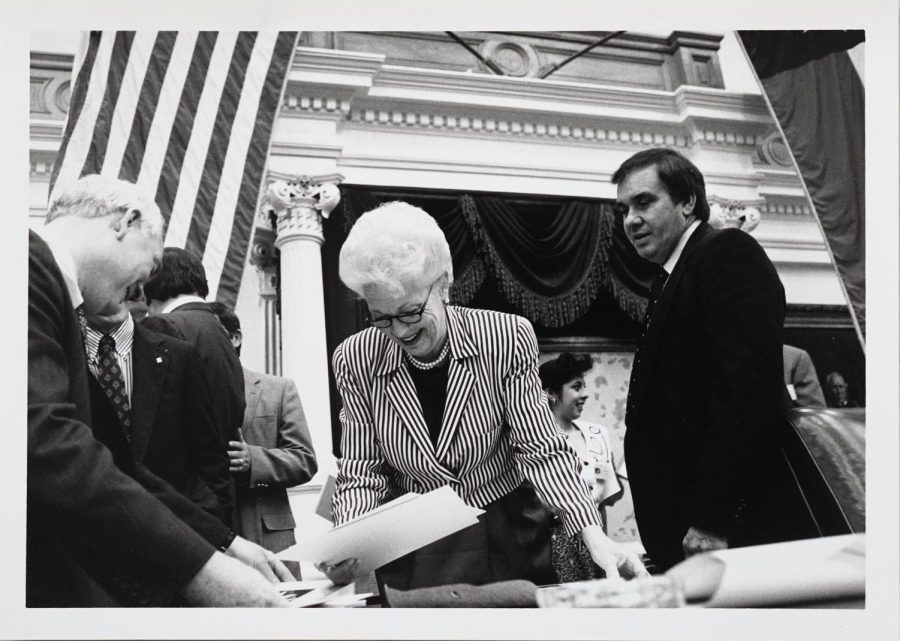
REICHMAN: “Ann Richards was governor when I worked there [at the Texas Legislature]. Ann was a delight to photograph. Have you ever done any dark room work? No? The interesting thing about Ann was that her hair was so white. When we because we printed all those black-and-white pictures, if she was in the picture with somebody else, we had to whiten her and darken them just because of her hair. And she was very pale in skin.”
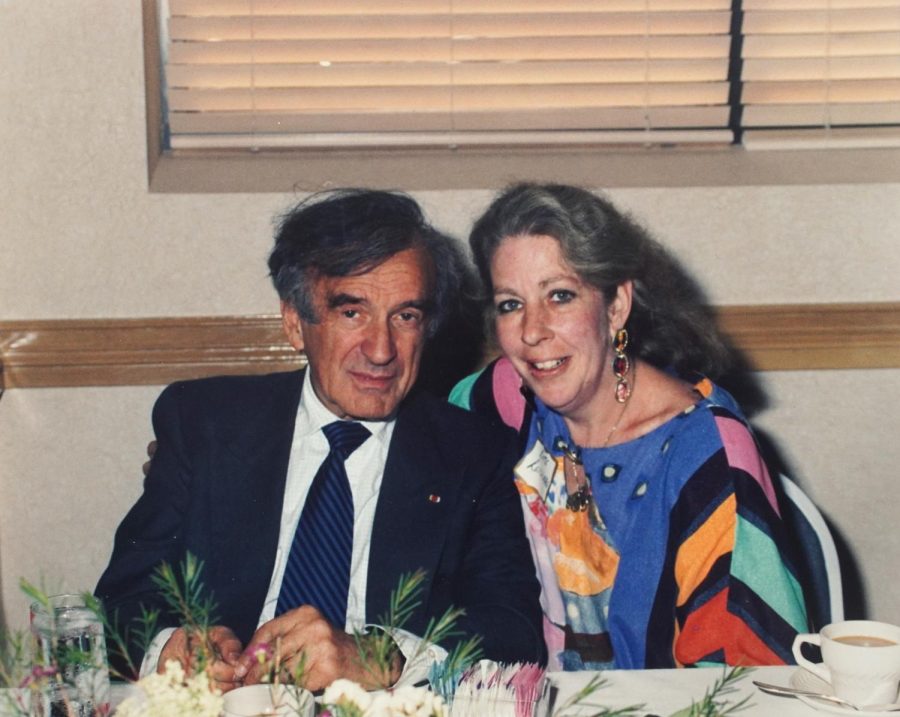
REICHMAN: “Here’s one of my favorites with me and Elie Wiesel. Well, that was from one of the first times that I photographed Elie Wiesel, and I photographed him a couple more times after that, and this was a dinner with Gov. Bush. And when he came, this guy was all askew, and his hair was all messed up. And I said, ‘Oh, let me just straighten.’ ‘No, no, no, no,’ he said. ‘It wouldn’t be a picture of me if you straightened any of that.'”
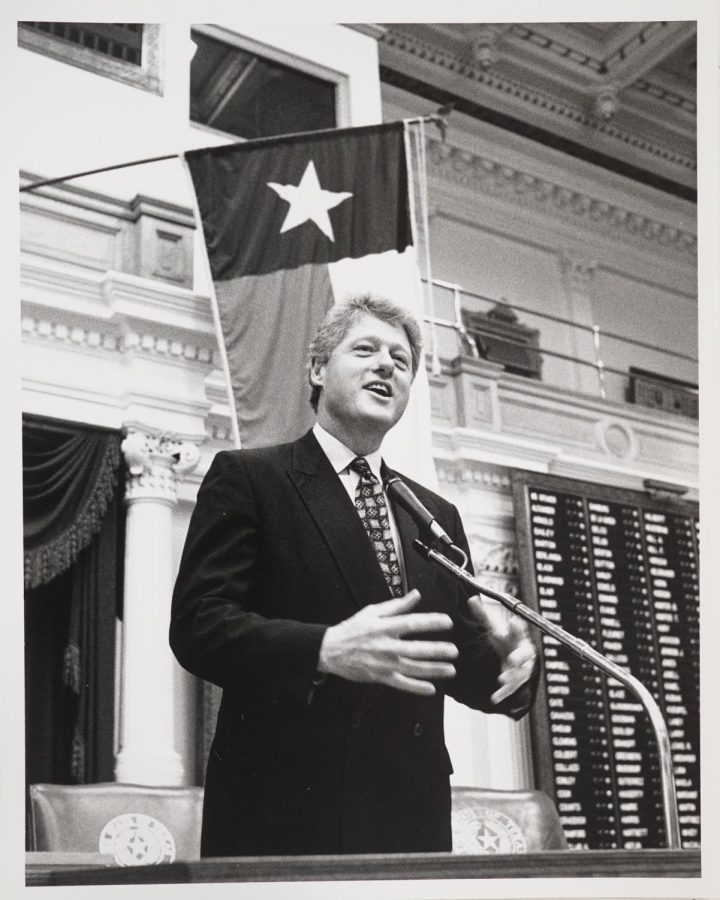
REICHMAN: “This was Bill [Clinton] before he was president. He went to the House floor and I went, ‘Who’s that man?” And this person said, “That’s the next President of the United States.’ And I said, ‘Really?'”
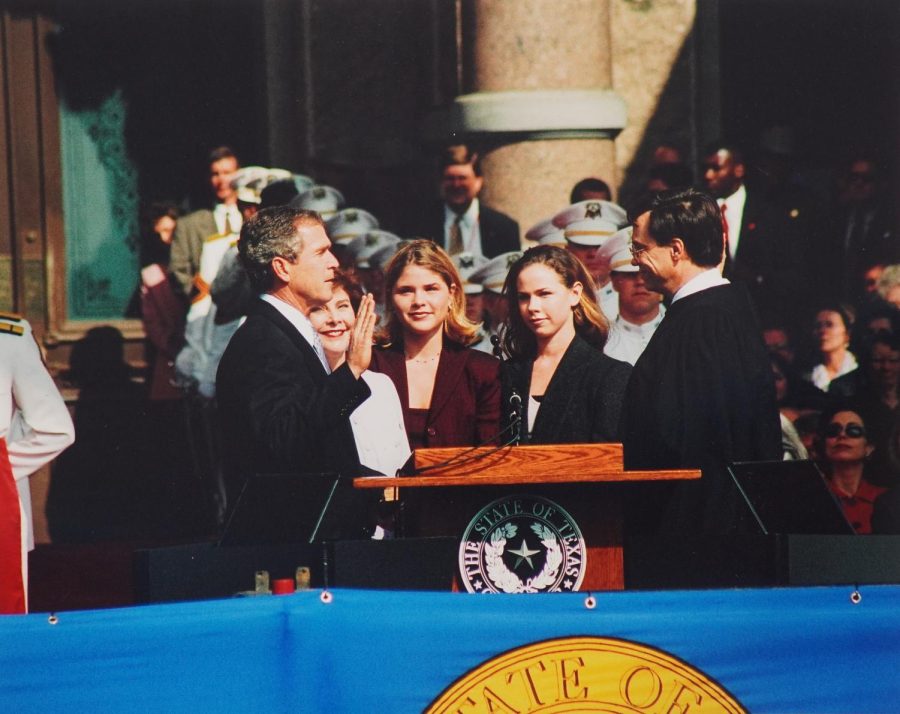
REICHMAN: There’s George on Inauguration Day some time way back. I am not sure when. [He was inaugurated for a second time as the governor of Texas on Jan. 19, 1999 on the south steps of the Texas Capitol.]
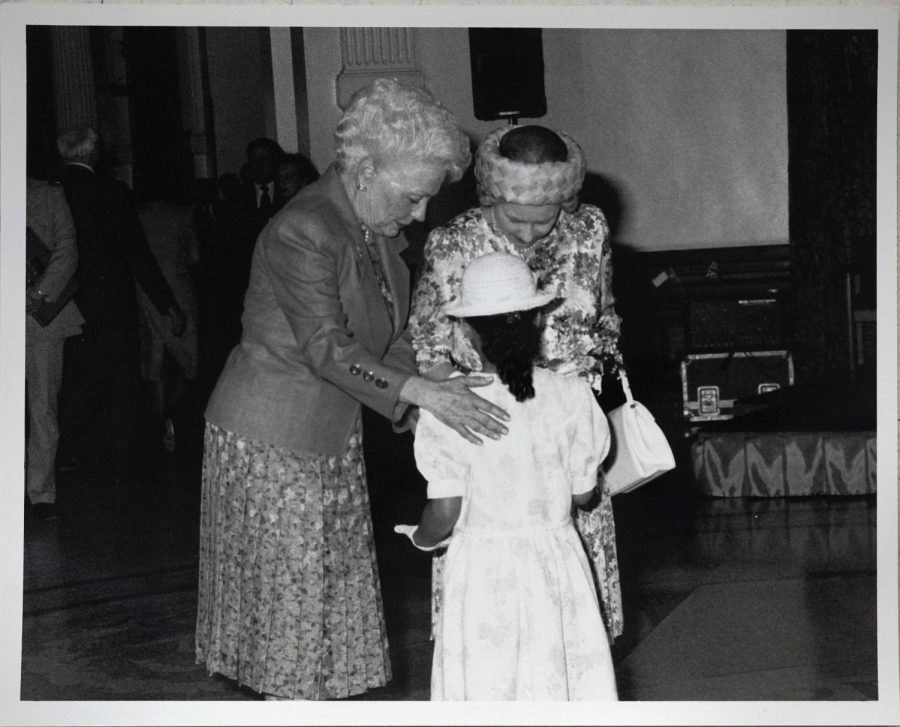
REICHMAN: “There’s the queen. When she came to Texas, it was cool. We were all excited, and everybody had designated spots, somebody where she got out of the car and somebody was in the rotunda, and somebody, balcony. And I was actually in the rotunda. I got a picture of Ann Richards’ granddaughter Cecile—you know, the head of Planned Parenthood [as an adult], she was just a little girl [back then]—giving the queen flowers.”
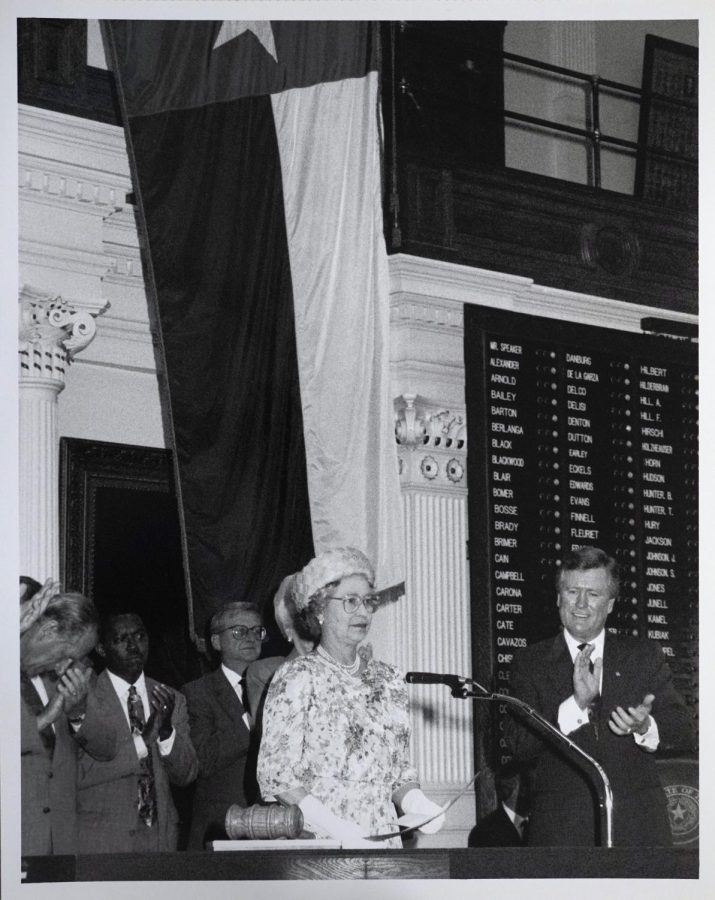
REICHMAN: “And then everyone said, ‘Quick, quick! Go inside! Get close!’ But you know, y’all had to have clearance and pins, and and I said, ‘Oh, no,‘ and they said, ‘Yeah, go! If you get arrested, we’ll get you out.’ I went, I got really close [to the Queen Elizabeth], which was really cool.”

REICHMAN: “This is a picture after Gov. Bush was declared president, You know that took a while because of hanging chads? And so when he was declared president, this is his inner group. Yeah. Mark McKinnon. Where’s Carl Rove? He’s gonna be here somewhere. Anyway, these are his people. They called and said, can I come take pictures at this party and it was around December, so it was Christmas party season. So I said, ‘I really have this Christmas …’ ‘Well, can you come for just part of the time?’ And I thought, ‘I can’t tell them no. He just found that he’s the president. I’ll just have to tell my client “I’m sorry. I’m an hour late.”‘ That’s how it went. We did this picture of the intimate group.”
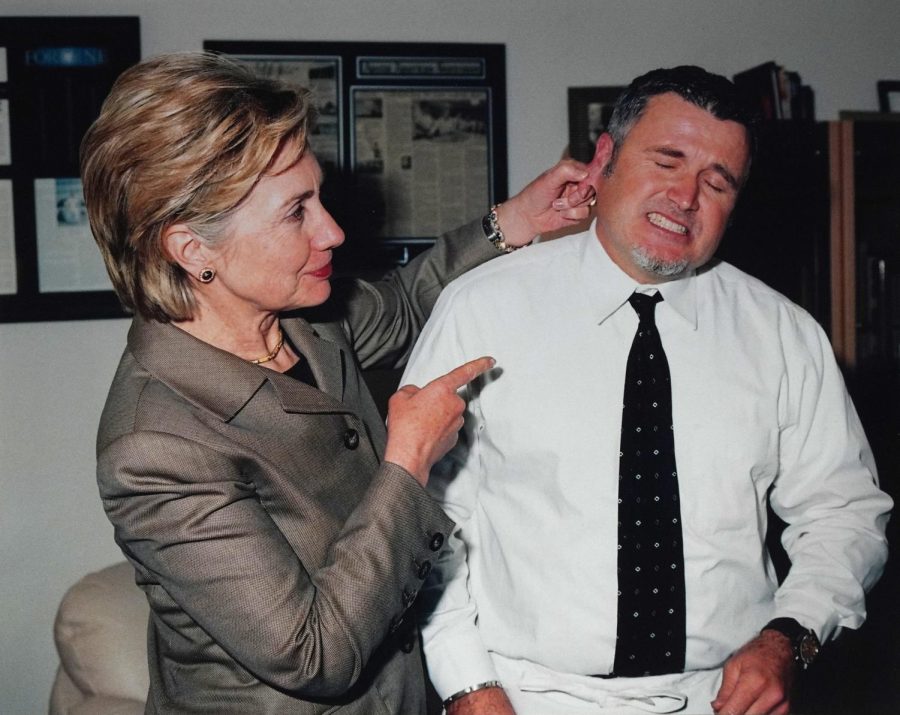
REICHMAN: “I used to shoot when the Clintons came to town. And this was when she was running for president. And it was at a client’s house. And it was after the party was over. And everybody’s sitting around telling jokes. And she’s got a great sense of humor. And the one of the catering staff said, ‘Would you mind taking this picture where you do such and such and so on, so my mother will love it?’ and so that’s what that picture is.”
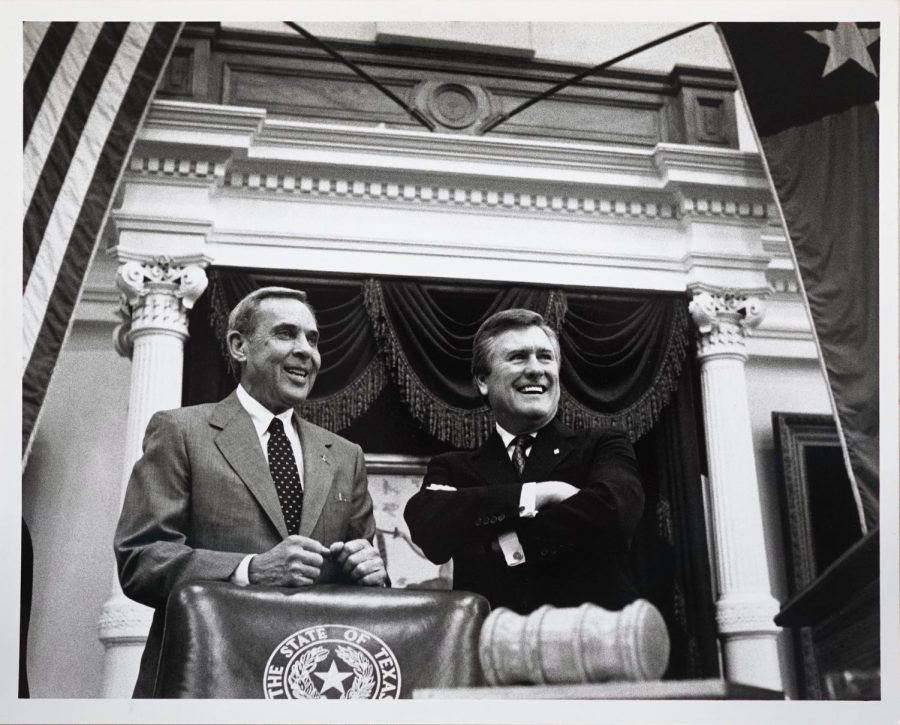
REICHMAN: “That’s Gib Lewis [right], and he was Speaker of the House. And next to him is Bob Bullock [left], whom the Bob Bullock Museum is named for, and he was the lieutenant governor, which is the most powerful job in the state, more powerful than the governor. He’s first in power; he’s second in power, and the governor is third. They were at the podium, and it was when I worked at the legislature.”
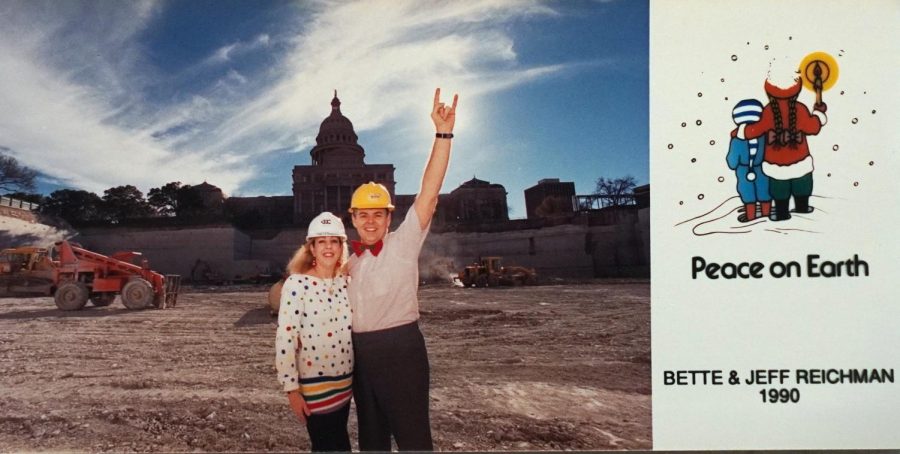
REICHMAN: “That was our holiday card. I took on the job of both photographing the hole for the extension. You’ve been to the Capitol? You’ve been in the extension? I had degrees in art history. So when the opportunity came up, I said, ‘Oh, I’ll take that project,’ because I figured I’ll make it so that whoever’s doing the research in the future could have what I would want as a researcher. So I followed [the construction], documenting from the removal of these giant oak trees to the digging. And so we got to, you know, have special privileges because I’d been photographing and that was our holiday card in 1990. Yeah, that was on a tripod.”
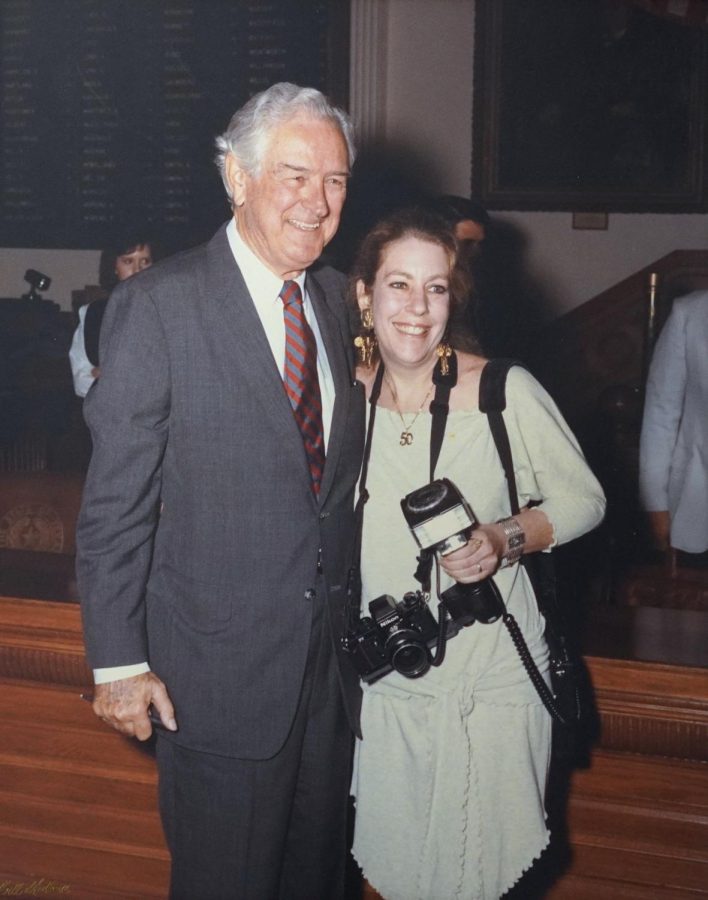
REICHMAN: “Here’s me and John Connally. Wasn’t I cute? That was at the legislature. And John Connolly. You know, John Connolly. He had been a Democrat and then became a Republican and you know, was shot was Kennedy and stuff. And he was just super cool.”
THE SHIELD: “Yeah. You’re wearing the same necklace today that’s in that picture. That’s so cool.”
REICHMAN: “Do you know what this necklace is for? Months of marriage … when my husband and I were married 50 months. We celebrate every month still. Yeah, we’re at 559 months. Yeah, some months are better than others. [laughs]”
This story was originally published on The Shield Online on April 4, 2023.




































